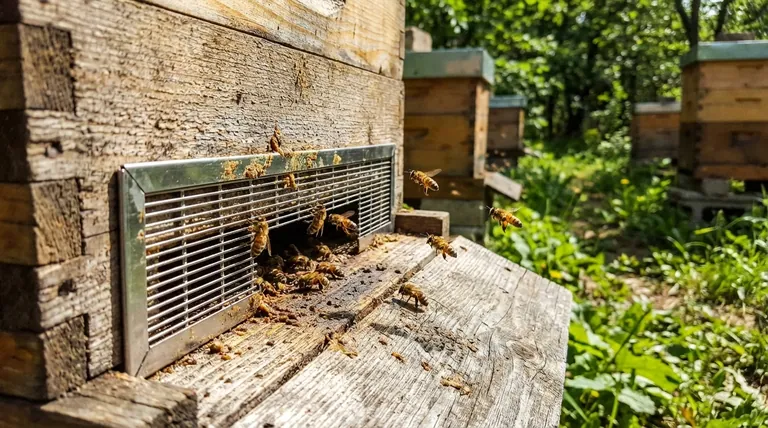The primary advantage of a metal entrance reducer is its superior durability against pests. Unlike wood, which can be chewed through, a metal reducer provides an impenetrable barrier that offers the most reliable protection for your hive, especially from mice seeking shelter during colder months.
While any entrance reducer helps a colony manage its environment and defense, a metal reducer is the definitive solution for long-term, chew-proof security against pests that can destroy a hive.

Why Use an Entrance Reducer?
Before focusing on the material, it's essential to understand the fundamental role of an entrance reducer. It is a critical tool for managing the health, stability, and defense of a honey bee colony.
Enhancing Hive Defensibility
A smaller entrance is far easier for guard bees to defend. This is crucial for new or weaker colonies that are prime targets for robbing bees from other hives, as well as wasps and hornets.
Regulating Hive Temperature
By reducing the size of the opening, the bees have less space to heat and cool. This helps them maintain a stable internal hive temperature, conserving energy and resources, particularly during the extreme temperatures of winter and summer.
Improving Ventilation Control
A properly sized entrance helps the colony manage airflow. A reducer allows bees to control ventilation more effectively, preventing excessive drafts while still allowing for necessary air exchange.
The Critical Role of Pest Protection
The hive entrance is a vulnerability. Pests, especially mice in the fall and winter, will try to enter the hive seeking warmth and food. Once inside, they can destroy comb, consume honey stores, and ultimately doom the colony.
The Core Advantage of Metal: Unmatched Security
While wooden reducers are common, they have a significant flaw that metal reducers solve completely. This distinction is most critical when the hive is at its most vulnerable.
Chew-Proof Security
This is the single most important benefit. Mice can, and frequently do, chew through wooden entrance reducers, particularly those made of soft pine. A metal reducer creates a hard stop, ensuring the entrance size you set is the size that remains.
Longevity and Weather Resistance
Metal is impervious to the elements in a way that wood is not. It will not rot, warp from moisture, or degrade from sun exposure. A metal reducer is a long-term, single-purchase investment for your apiary.
Consistent and Precise Sizing
Metal reducers, such as circular entrance discs or sliding gates, offer precise, clearly defined opening sizes. They do not wear down or become misshapen over time, ensuring their function remains consistent season after season.
Understanding the Trade-offs
No piece of equipment is without its considerations. Being objective about the material ensures you are making a fully informed decision for your specific needs.
Initial Cost
Metal reducers may have a slightly higher upfront cost compared to a simple wooden cleat. However, this cost is often offset by their longevity, as you will not need to replace them due to pest damage or rot.
Potential for Condensation
In very cold, damp climates, the cold surface of metal at the entrance could theoretically contribute to minor condensation. In practice, this is rarely a significant issue compared to the overwhelming benefit of pest protection.
Making the Right Choice for Your Hive
Choosing the right material comes down to balancing your budget, climate, and priorities for hive management.
- If your primary focus is overwintering hives in a cold climate: A metal reducer is the superior choice to guarantee protection from mice.
- If your primary focus is protecting new or weak colonies: Any reducer is critical, but a metal one provides the most reliable security against both insect robbers and rodent pests.
- If your primary focus is long-term value and durability: The one-time cost of a metal reducer is a better investment than repeatedly replacing damaged wooden ones.
Investing in a metal entrance reducer provides peace of mind and the most dependable defense for your colony's long-term health and security.
Summary Table:
| Advantage | Key Benefit |
|---|---|
| Chew-Proof Security | Impenetrable barrier against mice and pests, unlike wood. |
| Superior Durability | Resists rot, warping, and degradation from weather. |
| Long-Term Value | A single, lasting investment for your apiary. |
| Precise Sizing | Maintains consistent entrance size for optimal hive management. |
Secure your apiary's long-term health with professional-grade equipment from HONESTBEE.
We supply durable, reliable beekeeping supplies and equipment—like our chew-proof metal entrance reducers—directly to commercial apiaries and distributors through our wholesale-focused operations. Protect your investment and ensure your colonies thrive.
Contact HONESTBEE today to discuss your wholesale supply needs and get a quote!
Visual Guide

Related Products
- Metal Queen Bee Excluder for Beekeeping
- Professional Engraved Round Hive Number Tags for Beekeeping
- Professional Bamboo Queen Isolation Cage
- Professional Hive Front Entrance Bee Feeder
- HONESTBEE Entrance Bee Feeder Professional Hive Nutrition Solution for Beekeeping
People Also Ask
- What are the advantages of using excluders in terms of wax recovery? Maximize Your Yield of Premium Beeswax
- What is the purpose of a queen excluder? Achieve a Clean Honey Harvest & Organized Hive
- Should queen excluders be used in Flow hives? A Critical Guide for a Clean Harvest
- How does queen exclusion work in top-bar hives? A Guide to Natural Honey Barrier Management
- What is the purpose of using an excluder in beekeeping? A Guide to Hive Management & Honey Purity



















